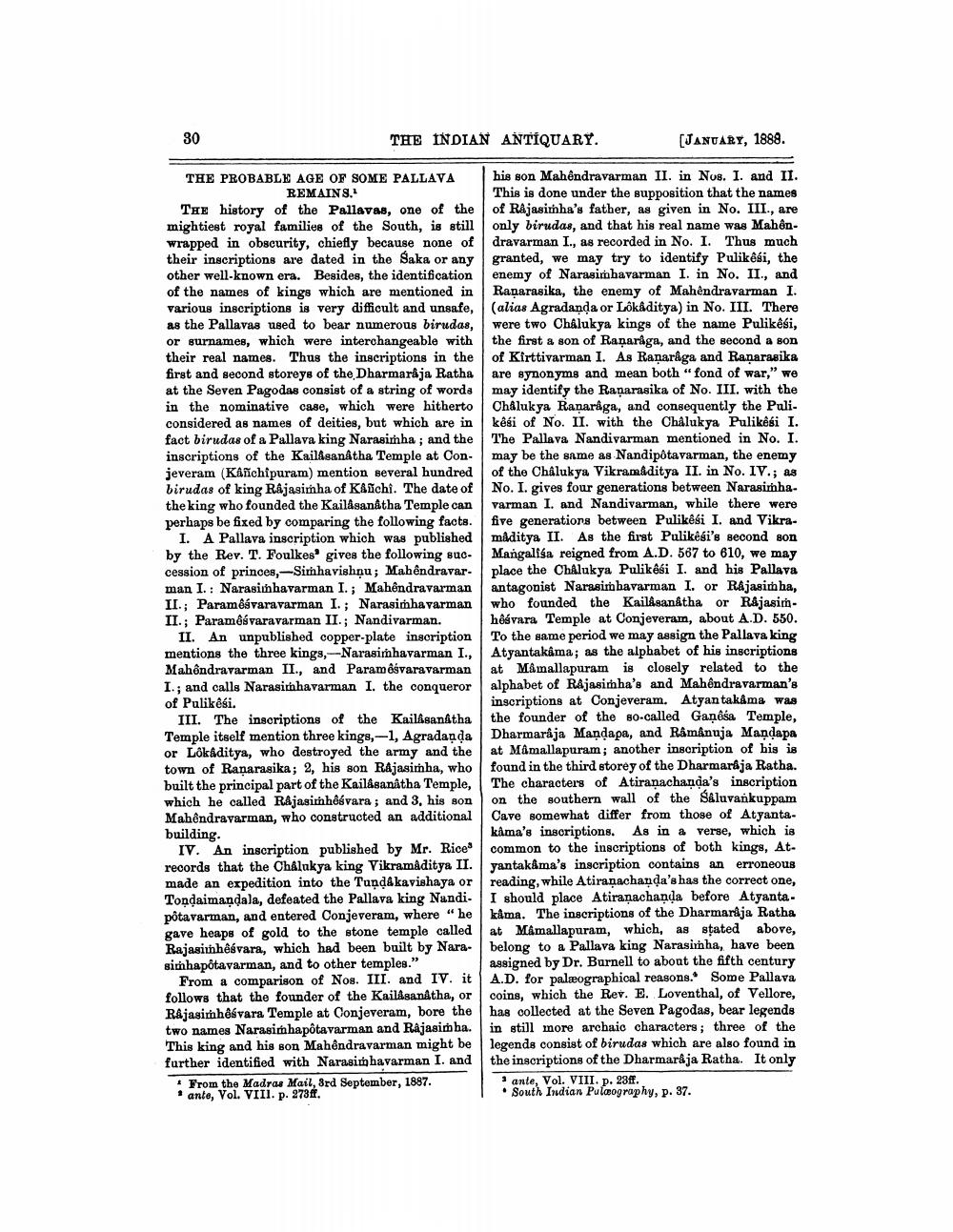________________
30
THE INDIAN ANTIQUARY.
[JANUARY, 1888.
THE PROBABLE AGE OF SOME PALLAVA his son Mahendravarman II. in Nos. I. and II. REMAINS.
This is done under the supposition that the names THE history of the Pallavas, one of the of Rajasimha's father, as given in No. III., are mightiest royal families of the South, is still only birudas, and that his real name was Mahônwrapped in obscurity, chiefly because none of dravarman I., as recorded in No. I. Thus much their inscriptions are dated in the Saka or any granted, we may try to identify Pulikêái, the other well-known era. Besides, the identification | enemy of Narasimhavarman I. in No. II., and of the names of kings which are mentioned in Ranarasika, the enemy of Mahendravarman I. various inscriptions is very difficult and unsafe, (alias Agradanda or Lökâditya) in No. III. There as the Pallavas used to bear numerous birudas, were two Chalukya kings of the name Pulikesi, or surnames, which were interchangeable with the first & son of Ranarâga, and the second a son their real names. Thus the inscriptions in the of Kirttivarman 1. As Ranaråga and Ranarasika first and second storeys of the Dharmaraja Ratha are synonyms and mean both "fond of war," we at the Seven Pagodas consist of a string of words may identify the Raņarasika of No. III. with the in the nominative case, which were hitherto Chalukya Ranaråga, and consequently the Pali. considered as names of deities, but which are in kési of No. II. with the Châlukya Pulikesi I. fact birudas of a Pallava king Narasimha ; and the The Pallava Nandivarman mentioned in No. I. inscriptions of the Kailasanatha Temple at Con. may be the same as Nandipôtavarman, the enemy jeveram (Kanchipuram) mention several hundred of the Chalukya Vikramaditya II. in No. IV.; as birudas of king Rajasirha of Kanchi. The date of No. I. gives four generations between Narasimhathe king who founded the Kailasanatha Temple can varman I. and Nandivarman, while there were perhaps be fixed by comparing the following facts. five generations between Pulikesi I. and Vikra
I. A Pallava inscription which was published måditya II. As the first Pulikesi's second son by the Rev. T. Foulkes' gives the following suc. Mangalisa reigned from A.D. 567 to 610, we may cession of princes, --Simhavishņu; Mahendravar. place the Chalukya Pulikasi I. and his Pallava man I. : Narasimhavarman I.; Mahendravarman antagonist Narasimhavarman I. or Rajasith ha, II.; Paramsvaravarman I.; Narasimhavarman who founded the Kailasanatha or RajasinII.; Paramêsvaravarman II.; Nandivarman. håóvara Temple at Conjeveram, about A.D. 550.
II. An unpublished copper-plate inscription To the same period we may assign the Pallava king mentions the three kings,--Narasimhavarman I., Atyantakama; as the alphabet of his inscriptions Mahôndravarman II., and Paramôśvaravarman at Mamallapuram is closely related to the I.; and calls Narasimhavarman I. the conqueror alphabet of Rajastha's and Mahôndravarman's of Pulikesi.
inscriptions at Conjeveram. Atyan takama was III. The inscriptions of the Kailasanatha the founder of the so-called Ganesa Temple, Temple itself mention three kings,-1, Agradaņda Dharmaraja Mandapa, and Ramanuja Mandapa or LokAditya, who destroyed the army and the at Mamallapuram; another inscription of his is town of Ranarasika; 2, his son Rajasimha, who found in the third storey of the Dharmaraja Ratha. built the principal part of the Kailasanatha Temple, The characters of Atiranachanda's inscription which he called Rajasimhêsvara ; and 3, his son on the southern wall of the Saluvankuppam Mahôndravarman, who constructed an additional Cave somewhat differ from those of Atyantabuilding.
kâma's inscriptions. As in a verse, which is IV. An inscription published by Mr. Rice common to the inscriptions of both kings, Atrecords that the Châlukya king Vikramaditya II. yantakâma's inscription contains an erroneous made an expedition into the Tandakavishaya or reading, while Atiranachanda's has the correct one, Tondaimaņdala, defeated the Pallava king Nandi. I should place Atiranachanda before Atyantapõtavarman, and entered Conjeveram, where "he kama. The inscriptions of the Dharmarija Ratha gave heaps of gold to the stone temple called at Mamallapuram, which, as stated above, Rajasinhêsvara, which had been built by Nara- belong to a Pallava king Narasimha, have been simhapötavarman, and to other temples."
assigned by Dr. Burnell to about the fifth century From a comparison of Nos. III and IV. it A.D. for palmographical reasons. Some Pallava follows that the founder of the Kailâsanátha, or coins, which the Rev. E. Loventhal, of Vellore, Rajasimh&svara Temple at Conjeveram, bore the has collected at the Seven Pagodas, bear legends two names Narasimhapôtavarman and Rajasimba in still more archaic characters; three of the This king and his son Mahôndravarman might be legends consist of birudas which are also found in further identified with Narasith havarman I. and the inscriptions of the Dharmaraja Ratha. It only From the Madras Mail, 3rd September, 1887.
? ante, Vol. VIII. p. 23ff. • ante, Vol. VIII. p. 278ff.
• South Indian Pulæography, p. 37.




